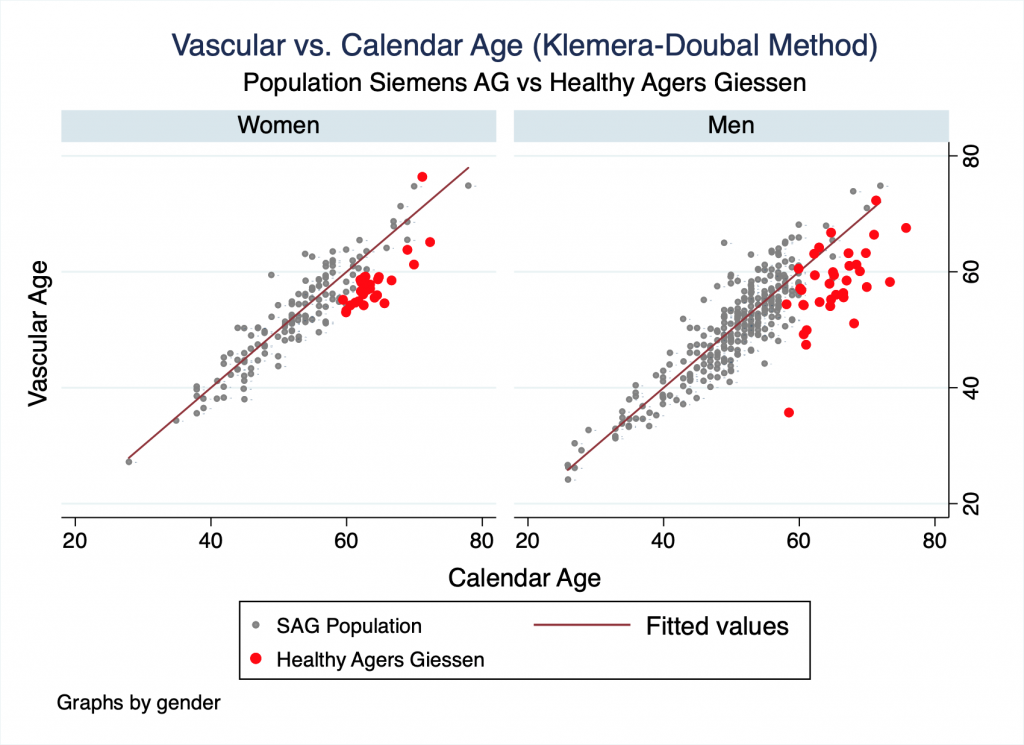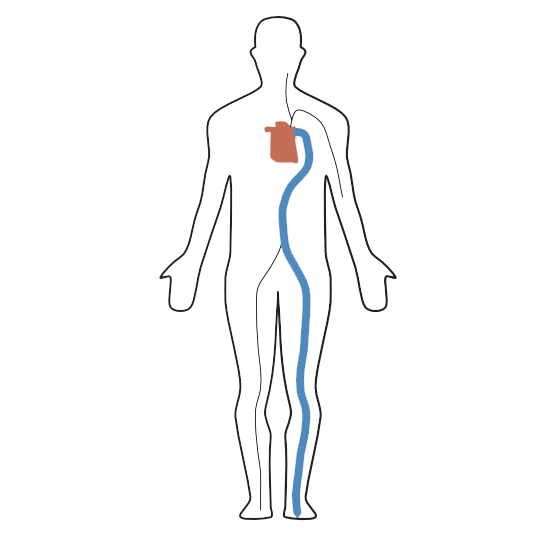The finding
Pulse wave velocity can be used to determine the pace of biological aging..
Why is this important?
Because pulse wave velocity can be measured at home with mHealth technology that is suitable for laypersons.
What’s next?
The N-of-1 based lifestyle optimization to slow down biological aging.
How the heart and the arteries work together
The heart beats about 100,000 times per day, pumping 60-80 ml of blood into the arteries with each contraction (systole), a full 75 hectoliters per day.
The large arteries in particular, such as the aorta, are elastic and expand when they receive the bolus of blood expelled by the heart. When they contract again, they drive the received blood bolus further under their own power.
This ensures that blood flows through the arteries even when the heart muscle relaxes between two “beats” (diastole).
The more elastic the arteries, especially the aorta, the more pumping work they take from the heart. The stiffer the arteries, the more strain they put on the heart.
With age and certain diseases, the arteries become stiffer.
This observation is several hundred years old. The English physician Thomas Sydenham (1624 – 1689) is credited with the saying “Man is as old as his vessels”:
This was the birth of the concept of vascular age.
Why vascular age is different from calendar age
Today, vascular age is calculated on the basis of mathematical models that include pulse wave velocity (PWV) as an essential parameter.
The PWV describes (in meters per second) how fast the blood pressure wave originating from the heart propagates in the arterial vascular tree. The stiffer the vessels, the faster the pulse wave and the higher the PWV.
Lifestyle habits and health behavior determine the PWV to a large extent. And thus also the vascular age.
Thus, vascular changes are detectable already in adolescence [1].
But from the 4th or 5th decade of life, the differences between individuals can be so significant that the arteries of some are significantly older than their calendrical age would suggest, and those of others are significantly younger. Early Vascular Aging (EVA) is one term, and SuperNormal Vascular Aging (SUPERNOVA) is another [2].
Figure 1 shows how we were able to determine the rate of arterial aging in over 500 subjects and derive a formula to calculate it.

From the figure, we can see how the over-60s who do not have any cardiovascular diseases and do not take any medications (successful agers) age on average at a 10-15% slower pace. That is, per year they age by only 10-11 months, not 12 or more. That doesn’t sound like much, but it makes a difference of about 10 years in health and life expectancy. So, 10 more years without diabetes, heart attack, stroke or dementia.
Our “successful agers” achieved this because they had adopted, more or less by chance, the exact health behaviors that matched their genes.
How to utilize PWV
Today, with PWV measurement and N-of-1 based lifestyle management, nobody needs to rely on chance.
That’s why we’ve added PWV measurement to LiLo’s arsenal of key vital signs.
The company Withings has managed to make the measurement of PWV suitable for laymen and to integrate it into a WLAN-enabled body scale. It is therefore an integral part of LiLo’s mHealth fleet, because keeping the vessels younger is the best insurance yet for lifelong health and functionality.
No one should really ignore their PWV, because with the performance of the arteries you determine the load and service life of that pump, which, within a mere 40 years could fill an oil tanker with a capacity of 95 million liters.
References
[1] Nemetz PN, Roger VL, Ransom JE, Bailey KR, Edwards WD, Leibson CL. Recent trends in the prevalence of coronary disease: A population-based autopsy study of nonnatural deaths. Arch Intern Med 2008;168:264–70. doi:10.1001/archinternmed.2007.79.
[2] Park J, Avolio A. Arteriosclerosis and atherosclerosis assessment in clinical practice: Methods and significance. Pulse 2023:1–14. doi:10.1159/000530616.

